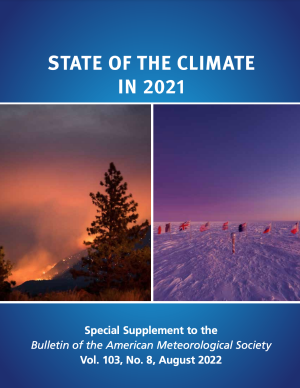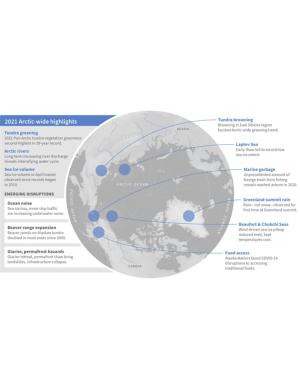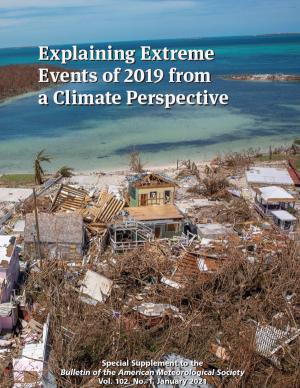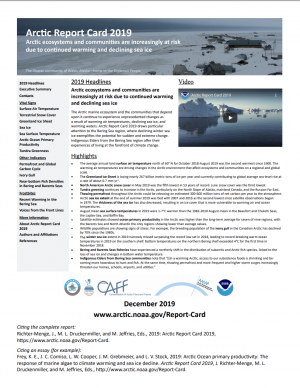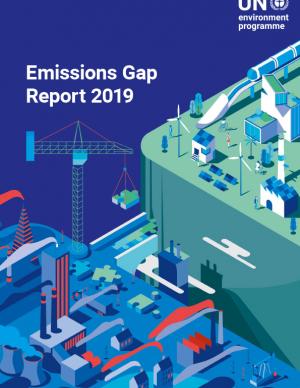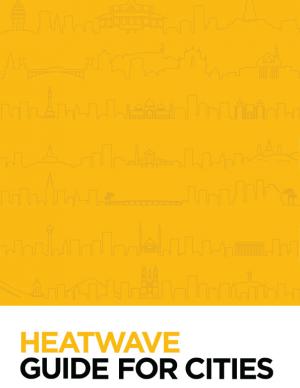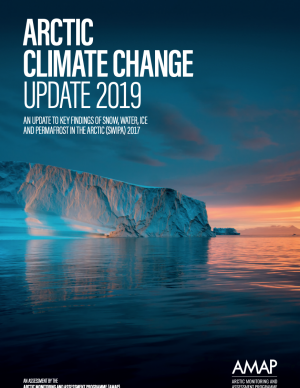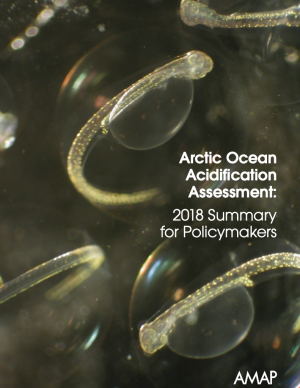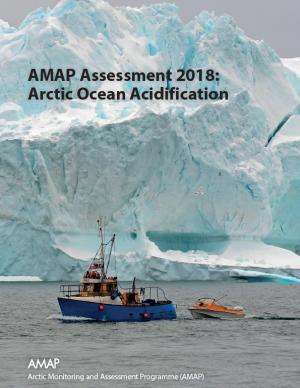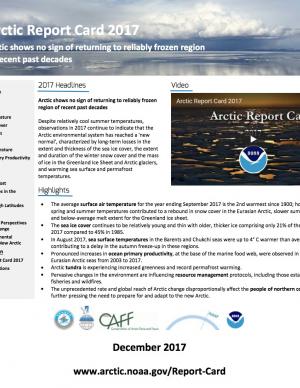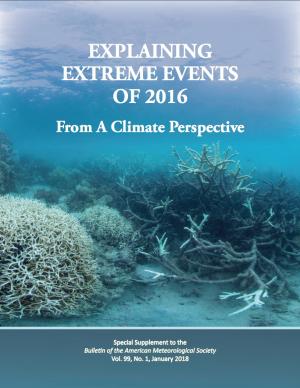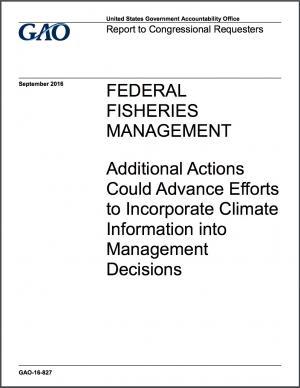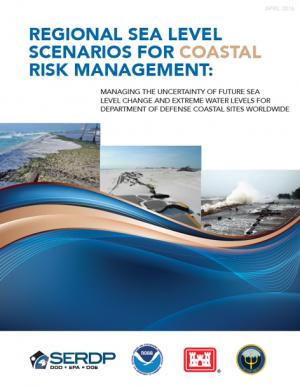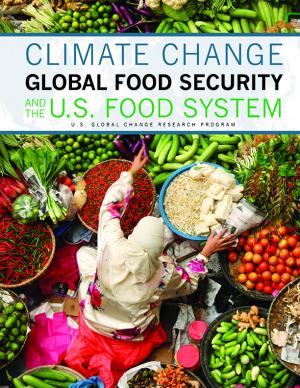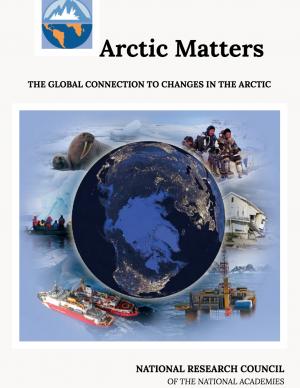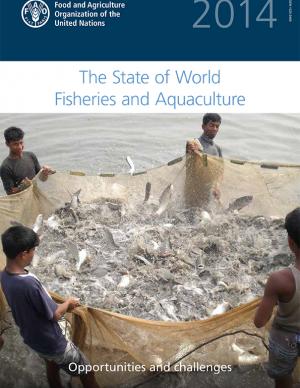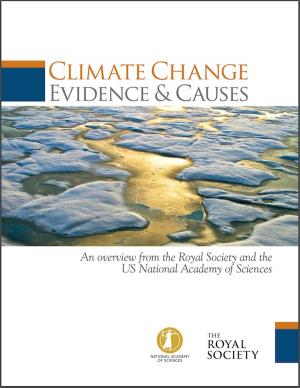Access a range of climate-related reports issued by government agencies and scientific organizations. Browse the reports listed below, or filter by scope, content, or focus in the boxes above. To expand your results, click the Clear Filters link.
An international, peer-reviewed publication released each summer, the State of the Climate is the authoritative annual summary of the global climate published as a supplement to the Bulletin of the American Meteorological Society. The report, compiled by NOAA’s National Centers for Environmental Information, is based on contributions from scientists from around the world. It provides a detailed update on global climate indicators, notable weather events, and other data collected by environmental monitoring stations and instruments located on land, water, ice, and in space.
As the influences of human-caused global warming continue to intensify, with the Arctic warming significantly faster than the globe overall, the 2021 Arctic Report Card (ARC2021) brings a broad view of the state of the Arctic climate and environment. The ARC2021 provides an update on seven Arctic Vital Signs, from sea ice to snow and air temperatures to tundra greenness, and checks in on three Indicator topics for updates on river discharge, ocean acidification, and observations of substantial Arctic beaver expansion. The noteworthy emerging topics in the four ARC2021 Frostbites—marine debris, marine noise, food access during the COVID-19 pandemic, and glacier and permafrost hazards—share a common link as they look at the impacts of more people and human activity in the Arctic as well as the challenges and hazards people face with the rapidly changing cryosphere. The scientific and observational story of the Arctic is a human story—of climate change, of increased shipping and industrial activity, and of communities responding to local and regional disruptions.
This is the FY22 edition of the U.S. Gllobal Change Research Program's annual report to Congress mandated by the the Global Change Research Act. The report provides an overview of the Program’s progress in delivering on its strategic goals as well as a summary of agency expenditures under USGCRP’s budget crosscut.
The Working Group II contribution to the IPCC Sixth Assessment Report assesses the impacts of climate change, looking at ecosystems, biodiversity, and human communities at global and regional levels. It also reviews vulnerabilities and the capacities and limits of the natural world and human societies to adapt to climate change.
This Working Group I contribution to the Sixth Assessment Report addresses the most up-to-date physical understanding of the climate system and climate change, bringing together the latest advances in climate science and combining multiple lines of evidence from paleoclimate, observations, process understanding, and global and regional climate simulations. The website for the report includes a Summary for Policymakers, a Technical Summary, an Interactive Atlas, a Frequently Asked Quetions (FAQs), Regional Fact Sheets, Data Access, Outreach Materials, and Errata.
This series of BAMS special reports presents assessments of how human-caused climate change may have affected the strength and likelihood of individual extreme events. The series has been published annually since 2011.
The ninth edition of the report, Explaining Extreme Events in 2019 from a Climate Perspective, presents 15 new peer-reviewed analyses of extreme weather across four continents and one sea during 2019. It features the research of 77 scientists from 7 countries looking at both historical observations and model simulations to determine whether and by how much climate change may have influenced particular extreme events.
Arctic ecosystems and communities are increasingly at risk due to continued warming and declining sea ice. The Arctic marine ecosystem and the communities that depend upon it continue to experience unprecedented changes as a result of warming air temperatures, declining sea ice, and warming waters. This 2019 update to the Arctic Report Card draws particular attention to the Bering Sea region, where declining winter sea ice exemplifies the potential for sudden and extreme change. Indigenous Elders from the Bering Sea region offer their experiences of living at the forefront of climate change.
The world continues to emit greenhouse gases while the planet's climate is changing faster than ever. This report intends to take up the latest and most essential scientific findings published in an extraordinary year—the climate science year in review.
As the world strives to cut greenhouse gas emissions and limit climate change, it is crucial to track progress towards globally agreed climate goals. For a decade, the Emissions Gap Report has compared where greenhouse gas emissions are heading against where they need to be, and highlighted the best ways to close the gap. This report presents the latest data on the expected gap in 2030 for the 1.5°C and 2°C temperature targets of the Paris Agreement. It considers different scenarios, from no new climate policies since 2005 to full implementation of all national commitments under the Paris Agreement. For the first time, it looks at how large annual cuts would need to be from 2020 to 2030 to stay on track to meeting the Paris goals. The report looks at the potential of the energy transition—particularly in the power, transport, and buildings sectors—and efficiency in the use of materials such as iron steel and cement.
Heatwaves are deadly and their impacts are on the rise globally due to climate change. People living in urban areas are amongst the hardest hit when a heatwave occurs because these are hotter than the surrounding countryside. It is crucial that cities incorporate heat-reduction tactics such as green spaces into their plans for growth or retrofit them in built areas; this emergency can only be avoided if city institutions, community groups, and planners contribute to reducing heat risk now and in the future. This guide is intended to help city staff take the first steps to understanding the heat risks they face, develop an early warning system, work with partners to consolidate heat action plans, and adapt urban planning practices.
Drawing and building on the findings of the Arctic Monitoring and Assessment Programme's (AMAP) 2017 Snow, Water, Ice and Permafrost in the Arctic (SWIPA) assessment, this document provides updated observations, information from other recent assessments, and conclusions from the latest reviews of Arctic trends and indicators. The pace of change in the Arctic is so rapid that new records are being set annually, and each additional year of data strengthens the already compelling evidence of a rapidly changing Arctic.
This Summary for Policymakers summarizes the findings of the AMAP Assessment 2018: Arctic Ocean Acidification report released in October 2018. It offers a review of the latest science relating to regional ocean acidification, the biological responses to it, an overview of case studies and their associated findings, and recommendations for the Arctic Council.
The continuing acidification of the Arctic Ocean is projected to have significant ecological and socioeconomic impacts over coming decades, with consequences both for local communities and globally. This is the overarching finding of the 2018 Arctic Ocean Acidification Assessment, presented at the 2018 Arctic Biodiversity Congress. The assessment, conducted by the Arctic Monitoring and Assessment Programme (AMAP) of the Arctic Council, updates a 2013 assessment and presents the chemical, biological, and socioeconomic impacts of ocean acidification, which is driven primarily by global greenhouse gas emissions.
This special report from the Intergovernmental Panel on Climate change describes the impacts of global warming of 1.5 °C above pre-industrial levels. The report also describes potential global greenhouse gas emission pathways, in the context of strengthening the global response to the threat of climate change, sustainable development, and efforts to eradicate poverty.
As incomes rise and populations grow, especially in the world’s hotter regions, the use of air conditioners is becoming increasingly common. In fact, the use of air conditioners and electric fans already accounts for about a fifth of the total electricity in buildings around the world–or 10 percent of all global electricity consumption. Over the next three decades, the use of ACs is set to soar, becoming one of the top drivers of global electricity demand. This new analysis by the International Energy Agency shows how new standards can help the world avoid facing such a “cold crunch” by helping improve efficiency while also staying cool.
Each year the Global Risks Report works with experts and decision makers across the world to identify and analyze the most pressing risks that we face. As the pace of change accelerates, and as risk interconnections deepen, this year’s report highlights the growing strain we are placing on many of the global systems we rely on. The top risks listed in this year's report, which reflect the concerns of global industry leaders, include extreme weather events, natural disasters, and failure of climate change mitigation and adaptation—ranked first, second, and fifth in likelihood and second, third, and fourth in impact, respectively.
The Arctic shows no sign of returning to reliably frozen region of recent past decades. Despite relatively cool summer temperatures, observations in 2017 continue to indicate that the Arctic environmental system has reached a "new normal," characterized by long-term losses in the extent and thickness of the sea ice cover, the extent and duration of the winter snow cover and the mass of ice in the Greenland Ice Sheet and Arctic glaciers, and warming sea surface and permafrost temperatures. Issued annually since 2006, the Arctic Report Card is a timely and peer-reviewed source for clear, reliable, and concise environmental information on the current state of different components of the Arctic environmental system relative to historical records. The report is intended for a wide audience, including scientists, teachers, students, decision makers, and the general public interested in the Arctic environment and science.
This BAMS special report presents assessments of how human-caused climate change may have affected the strength and likelihood of individual extreme events. This sixth edition of explaining extreme events of the previous year (2016) from a climate perspective is the first of these reports to find that some extreme events were not possible in a pre-industrial climate.
The sea ice surrounding Antarctica has increased in extent and concentration from the late 1970s, when satellite-based measurements began, until 2015. Although this increasing trend is modest, it is surprising given the overall warming of the global climate and the region. Indeed, climate models, which incorporate our best understanding of the processes affecting the region, generally simulate a decrease in sea ice. Moreover, sea ice in the Arctic has exhibited pronounced declines over the same period, consistent with global climate model simulations. For these reasons, the behavior of Antarctic sea ice has presented a conundrum for global climate change science. The National Academies of Sciences, Engineering, and Medicine held a workshop in January 2016 to bring together scientists with different sets of expertise and perspectives to further explore potential mechanisms driving the evolution of recent Antarctic sea ice variability and to discuss ways to advance understanding of Antarctic sea ice and its relationship to the broader ocean-climate system. This publication summarizes the presentations and discussions from the workshop.
This report documents that the average temperature in 2015 was over one degree higher than pre-industrial times and that the period 2011–2015 was the warmest five-year period on record, consistent with established warming trends. The report further documents that in 2015 another milestone was reached, with globally averaged CO2 levels of 400 parts per million (ppm). The year 2016 is on track to be even warmer and will be the first year in which CO2 at the Mauna Loa Observatory remains above 400 ppm all year, and for many generations to come.
The probability of extreme climate events since 2011, especially those involving extreme high temperatures, has been substantially increased by climate change, often by a factor of 10 or more. The single most significant event in humanitarian terms, with over 250,000 lives lost, was the 2011–2012 famine in the Horn of Africa, where drought was a major factor.
As climate changes and ocean temperatures rise, the abundance, distribution, and life cycles of fish in federally managed ocean fisheries may change too. Federal agencies managing ocean fisheries have limited information to determine exactly how climate change might harm specific fish populations, and may not always understand the potential effects. To better manage climate-related risks, the report recommends (1) the development of guidance on how to incorporate climate information into the fisheries management process, and (2) finalizing Regional Action Plans for implementing the NOAA Fisheries Climate Science Strategy that incorporate performance measures for tracking achievement of the Strategy’s Objectives.
A multi-agency team of researchers developed this Department of Defense report to provide regionalized sea level and extreme water level scenarios for the years 2035, 2065, and 2011 for 1,774 military sites worldwide. The information included in the report is meant to assist decision makers and others in making robust choices to manage their risk of future sea level and extreme water levels.
As climate has warmed over recent years, a new pattern of more frequent and more intense weather events has unfolded across the globe. Climate models simulate such changes in extreme events, and some of the reasons for the changes are well understood. Warming increases the likelihood of extremely hot days and nights, favors increased atmospheric moisture that may result in more frequent heavy rainfall and snowfall, and leads to evaporation that can exacerbate droughts.
Event attribution can answer questions about how much climate change influenced the probability or intensity of a specific type of weather event. As event attribution capabilities improve, they could help inform choices about assessing and managing risk, and in guiding climate adaptation strategies. This report examines the current state of science of extreme weather attribution, and identifies ways to move the science forward to improve attribution capabilities.
This peer-reviewed scientific assessment identifies climate change effects on global food security. Climate change is likely to diminish continued progress on global food security through production disruptions that lead to local availability limitations and price increases, interrupted transport conduits, and diminished food safety, among other causes. The assessment is a contribution to the U.S. National Climate Assessment, is called for under the President’s Climate Action Plan, and was led by the U.S. Department of Agriculture.
This report draws upon a large collection of peer-reviewed National Research Council reports and other national and international reports to provide a brief, reader-friendly primer on the complex ways in which the changes currently affecting the Arctic and its diverse people, resources, and environment can—in turn—affect the entire globe. Topics in the booklet include how climate changes currently underway in the Arctic are a driver for global sea level rise, new prospects for natural resource extraction, and rippling effects through the world's weather, climate, food supply, and economy.
This Synthesis Report summarizes the Fifth Assessment Report (AR5) of the Intergovernmental Panel on Climate Change (IPCC). This report distills, synthesizes, and integrates the key findings of the three IPCC Working Group contributions—The Physical Science Basis; Impacts, Adaptation, and Vulnerability; and Mitigation of Climate Change—to the AR5 for the benefit of decision makers in government, the private sector, and the general public. The report also includes findings from two Special Reports released in 2011: Renewable Energy Sources and Climate Change Mitigation and Managing the Risks of Extreme Events and Disasters to Advance Climate Change Adaptation. The Synthesis Report confirms that climate change caused by human activities is having impacts on ecosystems and human well-being across the U.S. and around the world.
A 24-year tradition encompassing the work of 425 authors from 57 countries, 2013's State of the Climate report uses dozens of climate indicators to track patterns, changes, and trends of the global climate system.
This publication, known by the acronym SOFIA, is released every two years to provide policymakers and civil society with a global view of fisheries and aquaculture and associated policy issues. The 2014 report includes a special study of initial assessments of vulnerabilities to climate change in fisheries and aquaculture. The full archive is available online.
This report focuses on livestock diseases that are sensitive to climate change. The report aims to help practitioners reduce the risks of key climate-sensitive infectious diseases by strengthening risk management systems for disease outbreaks. The three diseases chosen for the study—Rift Valley fever, Bluetongue, and East Coast fever—spread through “vectors” such as insects and parasites, the prevalence of which fluctuates depending on key weather and climate variables such as temperature and humidity. As the symptoms of climate change continue, the frequency and extent of these diseases are expected to escalate.
The Intergovernmental Panel on Climate Change (IPCC) Working Group II's contribution to the Fifth Assessment Report (AR5) relates to climate impacts, adaptation, and vulnerability. A Summary for Policymakers and the underlying scientific and technical assessment are also available.
The dramatic impact of climate variability and climate change continued to be felt all over the world throughout 2013. The World Meteorological Organization statement on the status of the global climate in 2013 provides a snapshot of global and regional trends in weather and climate over the past year and highlights some of the year’s most significant extreme events.
This report uses a Question and Answer format to discuss climate change and its causes. The booklet provides an authoritative overview of global climate change for decision makers, policy makers, educators, and other individuals seeking information on climate science.
This report provides a risk-based approach to achieve resilient water security in a changing climate, documents key trends, and highlights best practice from the Organization for Economic Cooperation and Development (OECD) Survey of Policies on Water and Climate Change Adaptation. The report examines options to improve the flexibility of water governance, policy, and financing approaches.
This report, representing the Intergovernmental Panel on Climate Change (IPCC) Working Group I's contribution to the IPCC Fifth Assessment report (AR5), explores the hard science elements of global climate change.
This report summarizes the current state of knowledge on potential abrupt changes to the ocean, atmosphere, ecosystems, and high-latitude areas, and identifies key research and monitoring needs. The report calls for action to develop an abrupt change early warning system to help anticipate future abrupt changes and reduce their impacts.
This guide is targeted towards program managers who work in climate change and health adaptation, and provides them with practical information and concrete guidance to mainstream gender throughout all four phases of the project cycle: identification, formulation and design, implementation, and monitoring and evaluation.

